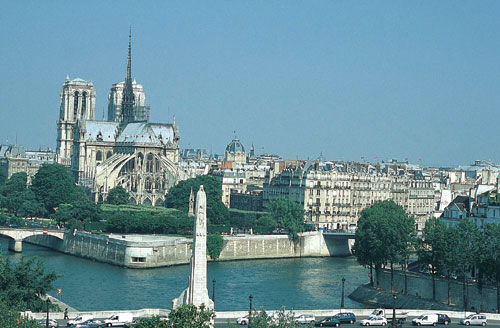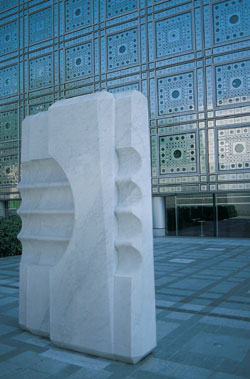|


On the bank of the Seine, with a view of the Île de la
Cité and Notre Dame, stands the amazing building of the IMA – the Institute du
Monde Arabe (the Arab World Institute).
The building is amazing mainly because of its extra-ordinary architecture which
earned the Aga Khan reward for Architecture. The purpose of the building is
amazing in its own right, for being the only institute in the world that is
totally dedicated to promoting knowledge of the Arab world and its culture.
It was built from 1981 till 1987 after a design by architect Jean Nouvel had won
the competition. The river façade follows the curve of the river Seine and helps
reduce the hardness of a rectangular block. In contrast, the opposite façade is
uncompromisingly rectangular. It appears like a metallic screen with movable
geometric motifs. This intricate structure holds several motor-and-light cell
controlled openings which act as a sunscreen to control the light entering the
building in accordance with the weather conditions of the various seasons. These
diaphragms operate exactly like those on an automatic controlled camera –
closing when the light is bright and harsh and opening on gloomy days. Thus
filtered light is created – an effect often used in Islamic architecture with
its climate-oriented strategies.

Inside the building is unusual also because of the fact that its internal
structures, including pipes and ducts are always visible. The staircases are
open and form a delicate lacework with these structures, a fascinating object
for black-an-white photographers.
The restaurant on the ground floor offers many well-known Arabic dishes, just
the thing for a fan of Middle-eastern cooking!
Access to the roof is gained by using a pedestrian walkway on the top floor that
spans the freight entrance between two parts of the building. This walkway is
not for the faint-hearted for the floor is transparent! The flat roof of the
building offers a great view towards the Notre Dame and a large part of the
centre of Paris.
Across from the main building, on the other side of a wide open square there is
a large shop where items from all over the Arab world are sold and a nice drink
of mint tea or qahwa can be enjoyed.
The institute, housed in the extra-ordinary main building, was formed to enable
cross-cultural understanding between the Arab nations and France. It was
established in 1980 by 18 participating Arab countries, with three more
countries joining since then. It was planned as a major institution that would
provide a permanent museum; space for regular temporary exhibitions; an
auditorium for lectures, debates, readings and musical performances; a cinema
showing films on Middle Eastern themes; a library for research; a bookshop
specializing in the Arab world; a magazine highlighting its themes and programs;
a great restaurant featuring the cuisine of Lebanon, Morocco and other Arab
locales; in short, it would be the Arab world's dynamic home address in Paris.
This objective has been achieved in a marvelous way.
The Arab Cultural Center has three aims:
1) to develop and increase the study of knowledge and understanding of the
Arab world and its civilization;
2) to encourage cultural exchanges, communication and cooperation between the
Arab world and France; and
3) to thus participate in the development of a closer relationship between
Europeans and Arabs.
Such objectives, to state the obvious, are of huge importance and urgency. It is
no substitute for encouraging governments and leaders to adopt better policies,
but fostering greater understanding through cultural interaction will in itself
have a significant impact on societies and policies.
Every Thursday lectures are held by local or visiting scientists and
researchers, linguists or archaeologists, musicians or movie-makers. Special
theme evenings are organized on a regular basis.
The impressive permanent collection from its founding countries includes
ceramics, ancient costumes, valuable parchments, bas-reliefs, white-marble
statues, astrolabes (astronomical instruments) and jewellery. These objects
retrace the history of Arab-Islamic civilization.
In addition, the IMA regularly organizes various specific exhibits. Last winter
and exposition called “Venice and the Islamic world, anno 828-1797” received
exactly 248 851 visitors and then went on to be presented at the Metropolitan
Museum in New York. It was followed by a very interesting exhibit on the “Golden
Age of Arab Science”, which was reported extensively in an earlier issue of
Shindagah magazine. A major exhibit about the pharaohs drew many thousands of
visitors. In between there were exhibits of paintings and photographs and a
comprehensive show about Algiers and its history.
Until October 21st 2007 there is an exhibit called Furûsiyyah, dealing with
knights in Islamic countries, that shows many rare art objects never presented
before. It is the collection of the Furûsiyyah Art Foundation, consecrated to
the equestrian arts in Islam. The ancient pieces of art stem mainly from before
the 16th century – unknown in the art world and unmentioned in magazines,
catalogues or specialized publications. In recent years new items have been
added to this collection so that it now covers the era between the 8th and the
18th century. Anyone who visits Paris in October should make it a point to
admire this unique collection
Following this there will be a heritage exhibit about the Phoenicians of the
Mediterranean in the first millennium BC, while next year a major exhibit about
Napoleon’s exploits in Egypt will be presented.
The library has over 50.000 works and 1.200 periodicals in French and Arabic,
and also in German, English, Spanish or Italian. Readers are free to help
themselves from the shelves. Those who prefer to make their discoveries through
images and music can go down to the audio-visual centre.
The music and theatre programme changes along with the large exhibitions. It
includes a mixture of popular or contemporary music, festivals and seasons,
dance, comedy, poetry and sketches where French mingle with Arabs in an
atmosphere reminiscent of an oriental café.
|